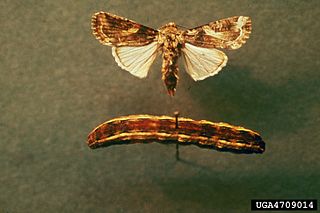
Spodoptera ornithogalli is a moth of the family Noctuidae.
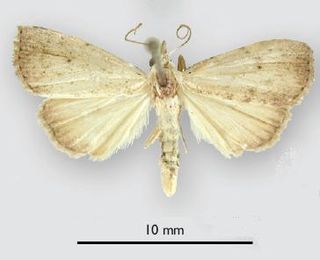
Rivula stepheni is a species of moth of the family Erebidae first described by James Bolling Sullivan in 2009. It is found in the US in eastern North Carolina, Louisiana and Florida.

Apamea verbascoides, the boreal apamea or mullein apamea, is a moth of the family Noctuidae. The species was first described by Achille Guenée in 1852. It is native to North America, where it is found from Saskatchewan to Newfoundland and Labrador and south to North Carolina.

Euxoa detersa, the rubbed dart, sandhill cutworm or sand cutworm, is a moth of the family Noctuidae. The species was first described by Francis Walker in 1856. It is found in North America from Newfoundland to North Carolina, west to Nebraska, north to Alberta and the Northwest Territories.
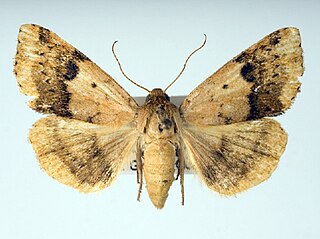
Heliocheilus lupatus, the purple topper, lupatus straw moth or spotted straw moth, is a moth in the family Noctuidae. The species was first described by Augustus Radcliffe Grote in 1875. It is found in the United States from Kentucky and central Connecticut south to Florida and Texas.

Macrochilo litophora, the angulate fan-foot or brown-lined owlet moth, is a litter moth of the family Erebidae. The species was first described by Augustus Radcliffe Grote in 1873. It is found in the United States from Wisconsin, east to Massachusetts, south to North Carolina, South Carolina, Mississippi and Texas.
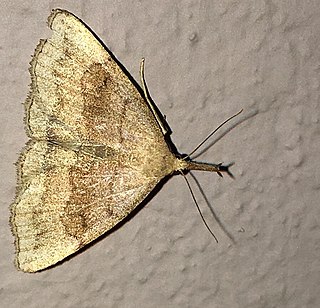
Phalaenostola metonalis, the pale phalaenostola, tufted snout or pale epidelta, is a moth of the family Erebidae. The species was first described by Francis Walker in 1859. It is found in North America from British Columbia to Newfoundland, south to North Carolina, west to Missouri.
Buckleria parvulus, the sundew plume moth, is a moth of the family Pterophoridae. The species was first described by William Barnes and Arthur Ward Lindsey in 1965 from Archbold Biological Station, Florida. It is found in the south-eastern United States, including Florida, North Carolina, Louisiana, Alabama, Georgia, Mississippi, South Carolina and Texas.
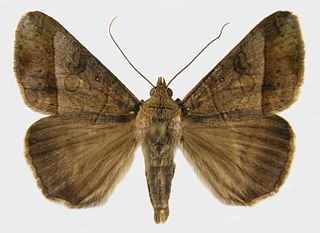
Mocis latipes, the small mocis moth or striped grass looper, is a species of moth of the family Erebidae. It is found from North America (from southern Ontario and Quebec to Florida, west to Arizona, north to Minnesota and south through Central to South America.

Acrolophus plumifrontella, the eastern grass-tubeworm moth, is a moth of the family Acrolophidae. It is found in North America, including Alabama, Arizona, Arkansas, Florida, Georgia, Illinois, Indiana, Iowa, Kansas, Kentucky, Louisiana, Maryland, Mississippi, Missouri, New Jersey, New York, North Carolina, Ohio, Pennsylvania, South Carolina, Tennessee, Texas and Virginia.

Acrolophus panamae, the Panama grass tubeworm moth, is a moth of the family Acrolophidae. It was described by August Busck in 1914. It is found in North America, including Alabama, Delaware, Florida, Georgia, Maryland, Mississippi, New Jersey, North Carolina, South Carolina and Virginia.
Acrolophus propinqua is a moth of the family Acrolophidae. It is found in North America, including Alabama, Florida, Georgia, Illinois, Louisiana, Maryland, Mississippi, North Carolina, New York, Ohio, South Carolina, Tennessee, Virginia and West Virginia.

Acrolophus cressoni is a moth of the family Acrolophidae. It is found in North America, including Alabama, Arizona, Arkansas, Florida, Georgia, Kentucky, Louisiana, Mississippi, New Mexico, North Carolina, Oklahoma, Tennessee and Texas.
Acrolophus piger, the piger grass tubeworm moth, is a moth of the family Acrolophidae. It was described by Harrison Gray Dyar Jr. in 1900. It is found in North America, including Alabama, Florida, Mississippi, North Carolina, South Carolina and Texas.
Crambus multilinellus, the multinellus grass-veneer, is a moth in the family Crambidae. It was described by Charles H. Fernald in 1887. It is found in North America, where it has been recorded from Florida, Georgia, Illinois, Maryland, Minnesota, Mississippi, North Carolina, Ontario and South Carolina.

Crambus quinquareatus, the large-striped grass-veneer, is a moth in the family Crambidae. It was described by Philipp Christoph Zeller in 1877. It is found in North America, where it has been recorded from Alabama, Florida, Georgia, Louisiana, Maryland, Mississippi, North Carolina, Oklahoma, South Carolina and Texas.

Crambus saltuellus, the pasture grass-veneer, is a moth in the family Crambidae. It was described by Philipp Christoph Zeller in 1863. It is found in North America, where it has been recorded from the north-eastern United States south to North Carolina. It is also present in southern Ontario.

Microcrambus biguttellus, the gold-stripe grass-veneer, is a moth in the family Crambidae. It was described by William Trowbridge Merrifield Forbes in 1920. It is found in North America, where it has been recorded from Alabama, Florida, Georgia, Illinois, Indiana, Kentucky, Maine, Manitoba, Maryland, Massachusetts, Michigan, Minnesota, Mississippi, New Brunswick, New Jersey, New York, North Carolina, Nova Scotia, Ohio, Oklahoma, Ontario, Quebec, South Carolina, Tennessee, Texas, West Virginia and Wisconsin. It has also been recorded from Cuba and Puerto Rico.
Thaumatopsis floridella, the Floridian grass-veneer, is a moth in the family Crambidae. It was described by William Barnes and James Halliday McDunnough in 1913. It is found in North America, where it has been recorded from coastal areas in Florida, Georgia, Mississippi, South Carolina and North Carolina, New Jersey, New York, and Rhode Island. It is also found in Cuba.
Haimbachia placidellus, the peppered haimbachia moth, is a moth in the family Crambidae. It was described by Frank Haimbach in 1907. It is found in North America, where it has been recorded from New York and Massachusetts to South Carolina, west to Tennessee.












